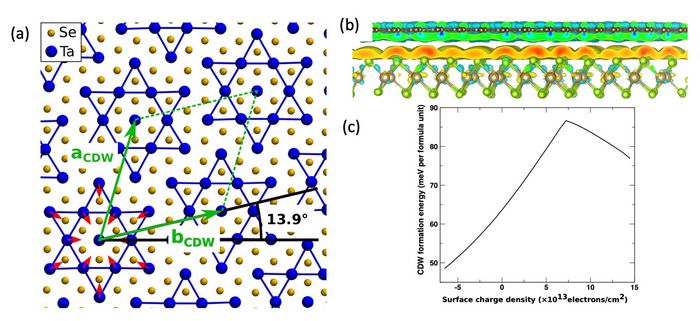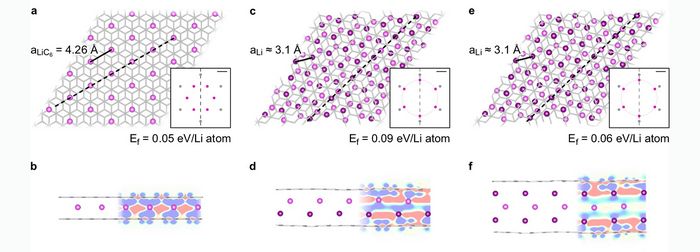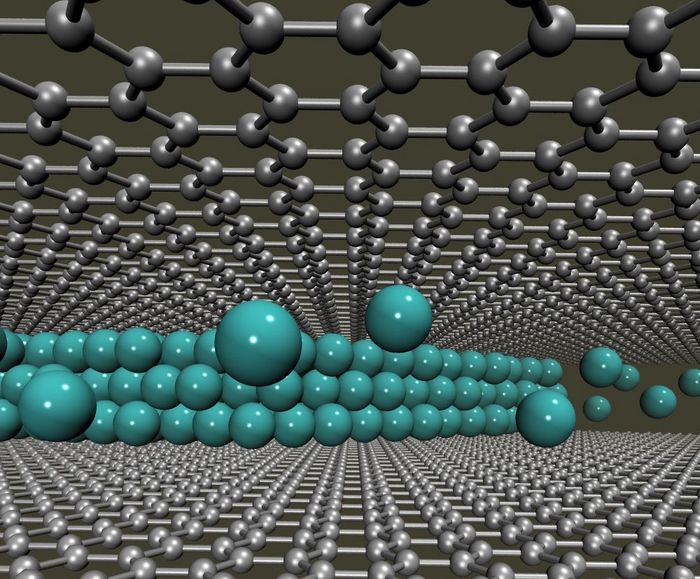MATERIALS SCIENCE AND CHEMISTRY
Two-Dimensional Inorganic Materials Under Electron Beam: Insights from Advanced First-Principles Calculations
Principal Investigator:
Arkady V. Krasheninnikov
Affiliation:
Helmholtz-Zentrum Dresden-Rossendorf (Germany)
Local Project ID:
PP16153638
HPC Platform used:
Hazel Hen of HLRS
Date published:
First-principles atomistic computer simulations which make it possible to simulate various materials without any input parameters from the experiment (except for the chemical elements the material consists of) are powerful tools in the modern materials science. Although they require supercomputers, they not only reproduce the structure and properties of the known materials, but also make it possible to predict new ones and describe the behavior of the system under various conditions, e.g., electron irradiation. In this project, irradiation effects in two-dimensional (2D) inorganic materials were studied with the main focus on transition metal dichalcogenides. The intercalation of Li atoms into bilayer graphene was also addressed.
Understanding the interaction of energetic electrons with matter is the key to tailoring materials structure and properties by, e.g., controllable introduction of defects and to the assessment of irradiation damage in the materials in radiation-harsh environments such as cosmic space, or in a laboratory – the column of a transmission electron microscope (TEM). This is particularly relevant to two-dimensional (2D) materials, which have recently been in the focus of research due to their unique properties and potential applications. However, a growing body of experimental facts indicate that many concepts of energetic particle-solid interaction are not applicable to these systems, as the conventional approaches based on averaging over many scattering events do not work due to their very geometry, e.g., in graphene--a membrane just one atom thick--or require substantial modifications. Among other issues which still are not understood, the results will explain in particular the development of irradiation damage in inorganic 2D materials under electron irradiation. Also, complete understanding of the behavior of composite materials, e.g. bilayer graphene with intercalated Li atoms, under electron beam is still a challenge.
In this research project, irradiation effects in 2D inorganic materials were studied using first-principles methods with the main focus on transition metal dichalcogenides. Novel computational atomistic techniques based on the density-functional theory (DFT), time-dependent DFT and the non-adiabatic Ehrenfest dynamics were used, which enable studying radiation effects from first-principles with account for electronic excitations. The intercalation of Li atoms into bilayer graphene was also addressed. Close collaboration with several leading experimental groups made an immediate verification and implementation of the theoretical concepts in state-of-the-art experiments possible opening thus new avenues for irradiation-mediated post-synthesis tailoring of the properties of 2D materials.
None of these insights could be achieved at the atomistic levels without supercomputers, as such calculations without any empirical parameters are computationally very expensive, and require massive parallel architecture. To this end, the access to the High-Performance Computing Center Stuttgart’s (HLRS) Hazel Hen supercomputer was crucial for the success of this project.

Fig.1. (a) Atomic structure of the CCDW/PLD in single-layer 1T-TaSe2 with Ta atoms colored blue and Se atoms colored orange. The Ta atoms show a star-of-David-like superstructure consisting of 13 Ta atoms. The outer 12 Ta atoms are displaced towards the center atom, indicated by red arrows. The unit cell of the commensurate superstructure is marked with the lattice vectors aCDW and bCDW to show the superstructure. The superstructure is rotated about 13.9° against the undistorted 1T structure. (b) Illustration of the charge transfer from graphene to 1T-TaSe2. Green/blue areas illustrate electron depletion and red/yellow areas electron accumulation, as compared to isolated layers. (c) Formation energy of the CCDW/PL as function of the surface charge density.
Copyright: Helmholtz-Zentrum Dresden-Rossendorf (Germany)Specifically, the effects of the electron beam on the structure and electronic properties of 2D transition metal dichalcogenides (TMDs) TaS2 and TaSe2 was investigated using first-principles computer simulations and TEM experiments [1,3]. The formation of defects, such as vacancies, was correlated with the changes in the TEM images of the so-called charge-density-wave patterns in these systems. The first-principles calculations provided insights into the energetics of the transformations as well as electronic structure of 2D MoTe2 under electron beam irradiation [5], and pointed out that some of the experimentally observed defects have localized magnetic moments. The results indicated that various nano-scale structures, including metallic quantum dots consisting of T’-phase islands and one-dimensional metallic systems such as vacancy lines and mirror twin boundaries embedded into a semiconducting host material can be realized in single-layer MoTe2, and defect-associated magnetism can also be added, paving new paths towards control of optical and electronic properties of two-dimensional materials. Overall, the results made it possible to better understand the effects of imperfections and defects on the electronic properties of TMDs, which are promising materials for applications in electronics and catalysis. 2D materials with interstitial-type defects were further investigated [4].
By combining TEM experiments and first-principles simulations within the framework of the density-functional theory, reversible superdense ordering of lithium between two graphene sheets was studied [2]. This research project was interesting in the context of energy storage, better understanding of the operation of Li-ion batteries and potentially their optimization and characteristic improvements. It was shown that not only single, but also multi-layer Li structure can be formed (at least in the bi-layer graphene), contrary to all previous works, albeit carried out for bulk graphite. The findings thus pointed to the possible existence of distinct storage arrangements of ions in 2D layered materials as compared to their bulk parent compounds. Identification of the atomic structure of Li between graphene sheets was possible due to extensive first-principles calculations. The simulations also provided insights into the dynamics of the process, that is diffusion of Li atoms, and addressed the role of the electron beam in the diffusion. They also made it possible to understand the role of electron-irradiation-induced defects in the nucleation of the Li phases.
With respect to the benefits of the society from the simulations, the results provided theoretical support to the ongoing fundamental experimental studies on 2D materials in the context of their future applications in electronics and energy solutions, and in particular explained the development of irradiation damage in inorganic 2D materials under electron irradiation.

Fig. 3. Atomistic models of Li crystals between AB-stacked graphene sheets obtained from DFT calculations. a, b, The ‘conventional’ C6LiC6 configuration with Li arranged in a commensurate superstructure between graphene sheets. c, d, Fully DFT-optimized bilayer Li crystal. e, f, Fully optimized trilayer Li crystal. Panels a, c, e are top views, and panels b, d, f are side views along the dashed line given in the respective top view. C atoms and sp2 bonds are grey, Li atoms are magenta. The insets in a, c, e schematically show diffraction patterns associated with the respective structure (scale bars, 2 nm−1), with first order diffraction spots from the Li (C) lattice indicated in magenta (grey). The close-packed Li phase in c, e may assume any relative rotation angle with respect to the bilayer graphene lattice at virtually no additional energy cost. A faint magenta circle indicates that the Li diffraction spots may therefore be rotated with respect to those of graphene. Ef is the energy required to take a Li atom from a bulk Li crystal and insert it between graphene sheets in the corresponding configuration. Contour plots in b, d, f represent the charge transfer between Li and graphene as compared to the isolated graphene and Li crystals. An increase in the electron density (negative charge) is shown blue, and a decrease in the electron density (positive charge) is shown red.
Copyright: Helmholtz-Zentrum Dresden-Rossendorf (Germany)References:
1. M. K. Kinyanjui, T. Björkman, T. Lehnert, J. Köster, A. Krasheninnikov, and U. Kaiser “Effects of electron beam generated lattice defects on the periodic lattice distortion structure in 1T−TaS2 and 1T−TaSe2 thin layers” Phys. Rev. B 99 (2019) 024101.
2. M. Kühne, F. Börrnert, S. Fecher, M. Ghorbani-Asl, J. Biskupek, D. Samuelis, A.V. Krasheninnikov, U. Kaiser, and J.H. Smet, “Reversible superdense ordering of lithium between two graphene sheets “, Nature 564 (2018) 234.
3. P. C. Börner, M. K. Kinyanjui, T. Björkman, T. Lehnert, A. V. Krasheninnikov, and U. Kaiser, “Observation of charge density waves in free-standing 1T-TaSe2 monolayers by transmission electron microscopy”, Appl. Phys. Lett. 113 (2018) 173103.
4. P. M. Coelho, H.-P. Komsa, H. C. Diaz, Y. Ma, A.V. Krasheninnikov, and M. Batzill, “Post-synthesis modifications of two-dimensional MoSe2 or MoTe2 by incorporation of excess metal atoms into the crystal structure”, ACS Nano 12 (2018) 3975.
5. T. Lehnert, M. Ghorbani-Asl, J. Köster, Z. Lee, A.V. Krasheninnikov, and U. Kaiser, “Engineering the structure and properties of single-layer MoTe2: from point to rotational and extended defects”, submitted for publication.
NOTE: This project was made possible by PRACE (Partnership for Advanced Computing in Europe) allocating a computing time grant on GCS HPC system Hazel Hen of the High Performance Computing Center Stuttgart, Germany (HLRS).
Scientific Contact:
Arkady V. Krasheninnikov
Helmholtz-Zentrum Dresden-Rossendorf
Germany (Germany)
e-mail: a.krasheninnikov [@] hzdr.de
March 2019
HLRS project ID: PP16153638
